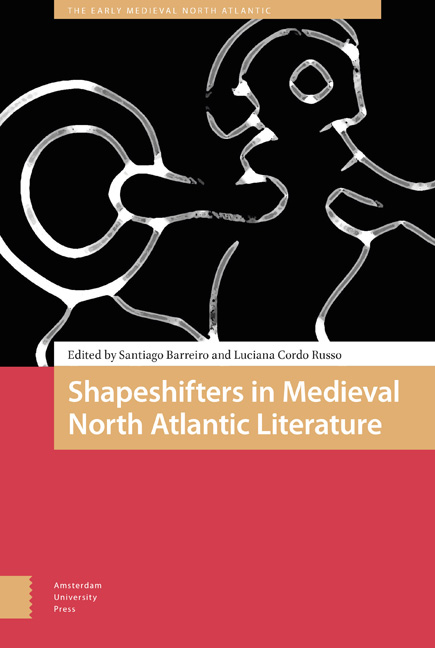Book contents
- Frontmatter
- Contents
- Acknowledgments
- Introduction: Medieval Thought and Shapeshifting
- 1 Wundor wearð on wege‘a wonder happened on the way’: Shifting shapes and meanings in Old English Riddles
- 2 The Big Black Cats of Vatnsdalr and Other Trolls: Talking about shapeshifting in medieval Iceland
- 3 The Hoard Makes the Dragon: Fáfnir as a Shapeshifter
- 4 Eigi í mannligu eðli: Shape, Monstrosity and Berserkism in the Íslendingasögur
- 5 The Cursed and the Committed: A Study in Literary Representations of ‘Involuntary’ Shapeshifting in Early Medieval Irish and Old Norse Narrative Traditions
- 6 Unde sunt aues istae?: Notes on Bird-Shapeshifting, Bird Messengers, and Early Medieval Hagiography
- 7 Sin, Punishment, and Magic: Changing Form in Medieval Welsh Literature
- Index
Introduction: Medieval Thought and Shapeshifting
Published online by Cambridge University Press: 16 February 2021
- Frontmatter
- Contents
- Acknowledgments
- Introduction: Medieval Thought and Shapeshifting
- 1 Wundor wearð on wege‘a wonder happened on the way’: Shifting shapes and meanings in Old English Riddles
- 2 The Big Black Cats of Vatnsdalr and Other Trolls: Talking about shapeshifting in medieval Iceland
- 3 The Hoard Makes the Dragon: Fáfnir as a Shapeshifter
- 4 Eigi í mannligu eðli: Shape, Monstrosity and Berserkism in the Íslendingasögur
- 5 The Cursed and the Committed: A Study in Literary Representations of ‘Involuntary’ Shapeshifting in Early Medieval Irish and Old Norse Narrative Traditions
- 6 Unde sunt aues istae?: Notes on Bird-Shapeshifting, Bird Messengers, and Early Medieval Hagiography
- 7 Sin, Punishment, and Magic: Changing Form in Medieval Welsh Literature
- Index
Summary
Sed et quidam adserunt Strigas ex hominibus fieri. Ad multa enim latrocinia figurae sceleratorum mutantur, et sive magicis cantibus, sive herbarum veneficio totis corporibus in feras transeunt. Siquidem et per naturam pleraque mutationem recipiunt, et corrupta in diversas species transformantur…
[Some people claim that witches were transformed from humans. With regard to many types of crimes, the appearance of the miscreants is changed, and they wholly metamorphose into wild animals, by means of either magic charms or poisonous herbs. Indeed, many creatures naturally undergo mutation and, when they decay, are transformed into different species…]
This passage, from the section De Transformatis in the eleventh book of Isidore's Etymologies, reveals three ways in which medieval learning explained shapeshifting: it could derive from moral causes (miscreants transformed due to crimes), from magic (the reference to charms) or it could be caused by natural action (as with poisonous herbs and decay). These three causes are paralleled in other thinkers, such as Arnulf of Orléans, who thought that metamorphoses were caused by natural, artificial, magical, or spiritual reasons.
Arnulf and Isidore are characteristic of a frequent medieval worldview which could be described as conceiving the different aspects of the universal order as closely interconnected with each other (and as stemming from God). This view logically considered the natural aspects of order as more fluid than a modern, post-Linnean view, and was dominant in the whole medieval period, or at least until the intellectual transformations brought about through neo-Aristotelian thought from the central Middle Ages onwards. In such a medieval mode of thought the change expressed through metamorphosis was an integral part of the created world, even if frequently circumscribed to remote geographical corners, or the effect of the work of specific agents, be they divine or demonic.
It is not difficult to imagine why the medieval multidimensional ideas about causation, nature, and transformation of beings were often also concerned with shapeshifters: these appear almost as embodiments of this fluid, interconnected image of reality. While our focus in this book is in its literary manifestations in Northern European contexts, the multitude of werewolves, swan-maidens, bear- and boar-men that appear in medieval narratives should not be thought as remnants of ‘primitive’ or ‘folk’ mentalities: shapeshifters were a core element of medieval cultures and were a concern even for the clerical, learned elite.
- Type
- Chapter
- Information
- Shapeshifters in Medieval North Atlantic Literature , pp. 9 - 20Publisher: Amsterdam University PressPrint publication year: 2018

